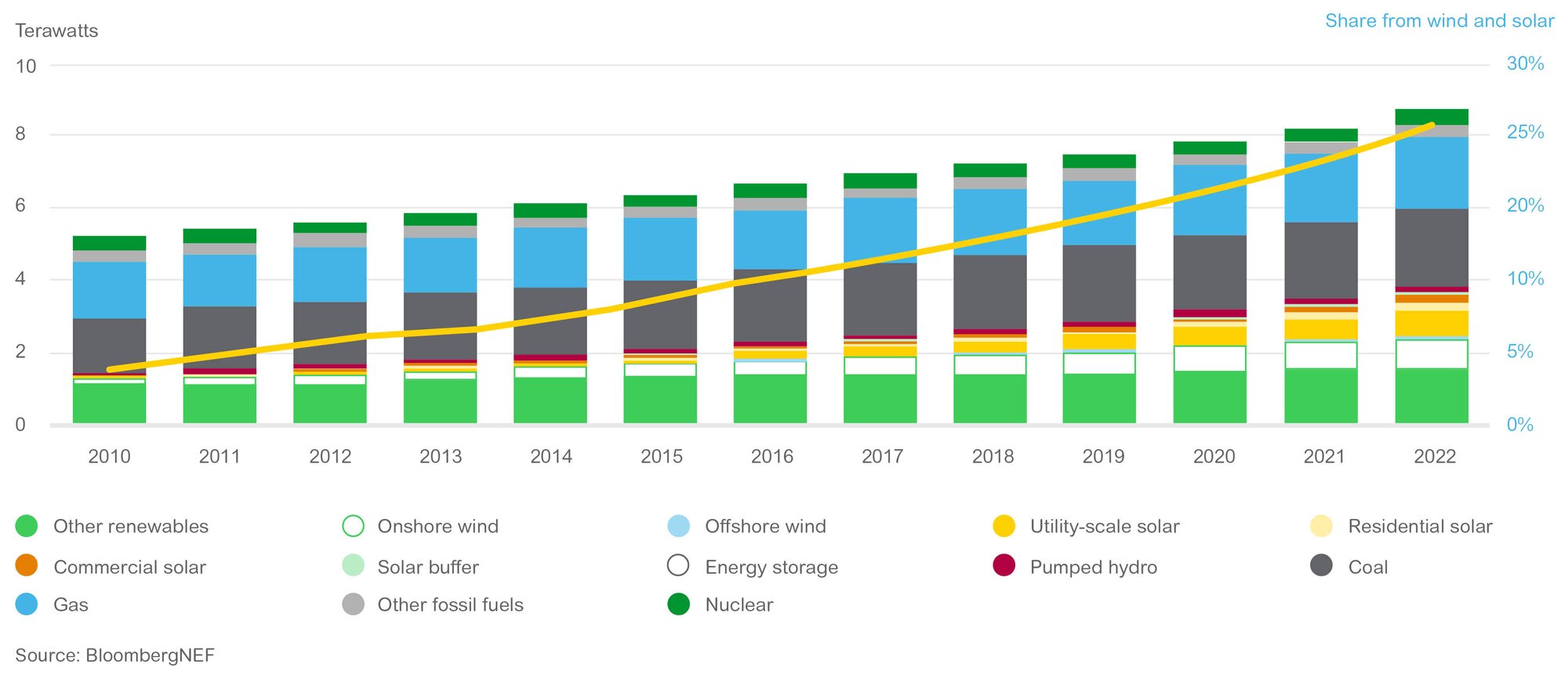2025 Global energy outlook: Building resilience in an uncharted market
- By Fabien Chene
- 02 Apr 20254 min read
The global energy market is undergoing a significant transformation, driven by technological innovations, evolving regulatory frameworks, the need for energy resilience, and changing consumer preferences. By prioritizing sustainable practices, organizations can adapt to these shifts, paving the path to new opportunities for transformation, resilience, efficiency, and business growth in an evolving energy landscape.
The current geopolitical landscape is significantly impacting the energy marketplace. Key energy benchmarks, including U.S. natural gas and European electricity prices, are experiencing heightened volatility, echoing trends from previous years. In 2024, the S&P 500 demonstrated relative stability with over 20% growth, whereas crude oil prices exhibited more volatility, concluding the year at similar levels to where they began.
Several geopolitical factors are influencing the energy market today, such as:
OPEC+ Production Cuts
OPEC+ countries are implementing significant production cuts, stabilizing crude oil prices despite heightened U.S. shale production.
Renewables Growth
Renewable energy is on an upward trajectory, with a solid economic foundation and continued growth expected.
Russia-Ukraine Conflict
The ongoing conflict has drastically reduced Russian natural gas supplies to Europe, leading to substantial shifts in European energy prices.
Middle East Tensions
Increased tensions involving Iran and other Middle Eastern countries pose risks to global energy supply.
U.S. Political Landscape
Shifts in U.S. energy policy will likely impact oil and gas production dynamics, influencing commodity prices and LNG exports.
LNG Market Dynamics
The U.S. has become the largest exporter of LNG, with its exports crucial in replacing lost Russian gas in Europe.
The interconnectedness of global energy markets means that geopolitical events in one region can have widespread implications elsewhere. Continuous monitoring of geopolitical developments and policy shifts will be essential for understanding their impact on energy supply and pricing dynamics.
Related event
Renewable energy sources like wind and solar have firmly established themselves as integral components of the global energy landscape, currently accounting for 25% of the total electricity fleet. When expanded to include other renewable technologies like geothermal and large hydro, renewables represent over 40% of global generation.

Global Power Generation Capacity Mix
Renewable energy has emerged as the most cost-effective option for new bulk power generation in many markets.
Despite political headwinds, corporate demand for renewable energy remains robust. Corporate power purchase agreements (PPAs) are on track to reach record levels, driven by tech giants such as Microsoft, Google, and Amazon. BNEF forecasts significant growth in renewable installations, predicting a 2.8-fold increase by 2030 and a 4.4-fold increase by 2035. Emerging technologies, including long-duration energy storage, green hydrogen, and advanced nuclear power, are crucial in bridging the gap toward net-zero goals.
Demand-side flexibility is expected to play a growing role as electrification increases across various sectors. Grid investments are crucial for accommodating the projected growth in renewables. Historical investments in transmission and distribution have not kept pace with net-zero requirements, indicating that solar and storage, alongside microgrid solutions, could be relied on more heavily to meet future energy demands.
Energy resilience is critical for achieving a sustainable and climate-ready future. Protecting the resilience of essential systems and operations has become increasingly challenging due to extreme weather events and rising energy demand. Factors such as new technologies, electrification, population growth, and industrial investments are contributing to the growing strain on energy infrastructure.
Integrated and renewable energy sources, distributed energy resources, and climate risk and adaptation planning are essential to address these challenges. The transition to renewable energy sources has led to the retirement of traditional baseload generation, underscoring the urgent need for grid updates and efficient interconnection processes. One of the biggest concerns is that the current regulatory structures and established processes for connecting to the grid or upgrading the grid are too slow to meet the incredible opportunity ahead.
Practical steps that businesses can take to build energy resilience include proactive communications with electric providers, exploring alternative energy solutions and new revenue streams from demand and load response program participation for instance, and staying informed about short-term trends in energy supply and demand.
Generative AI has rapidly grown, significantly impacting electricity demand. The International Energy Agency projects global data center electricity demand to reach over 1,000 terawatt-hours (TWh) in 2026. A recent study by Schneider Electric’s Sustainability Research Institute, titled Artificial Intelligence and Electricity: A System Dynamics Approach, analyzes AI energy consumption scenarios from 2025 to 2035 and reveals diverse trajectories with significant implications for future energy use and sustainability.

Global AI Electricity Consumption Forecasts From 2025 to 2035, in TWh
AI can enhance power utilization efficiency in data centers and optimize the performance of renewable energy sources, energy storage solutions, and distributed energy resources.
AI development strategies, policy frameworks, and governance will shape the future energy landscape and environmental impact of AI technologies. By embracing a balanced approach that integrates innovation with responsible stewardship, businesses can harness the full potential of AI while ensuring a resilient and sustainable energy future.
Addressing geopolitical influences, next-gen cleantech, energy resilience, and responsible AI is instrumental in guiding the path toward a sustainable energy future. Schneider Electric is working to empower businesses and communities to embrace innovative solutions that align with sustainable practices. By focusing on energy efficiency, renewable resources, and resilience, we can create a more balanced energy landscape that meets the needs of today while safeguarding our planet for future generations.
Download this brief and explore new opportunities to drive business growth and sustainability excellence.
Latest in Climate and Planet
Need help?
Product Selector
Quickly and easily find the right products and accessories for your applications.
Get a Quote
Start your sales inquiry online and an expert will connect with you.
Where to buy?
Easily find the nearest Schneider Electric distributor in your location.
Help Center
Find support resources for all your needs, in one place.
1. 什么是工业物联网?
这一概念将工业机械和设备与先进的传感器、软件和网络技术相结合。通过这种方式,您可以创建并连接一个自动化的生态系统。这样的数字化使智能工厂能够提高效率、员工安全性和可持续性。
工业物联网在制造业中的应用以及工业物联网解决方案的使用加速了制造过程并减少了浪费。因此,在保证地球安全的同时,生产力也得到提高。显然,它还可以减少停机时间,降低维护成本,因为它能够提供实时数据,从而引入预测性维护。
2.工业物联网解决方案如何推动工业4.0?
工业4.0指的是工业革命的一个新阶段,主要关注互连互通、自动化、机器学习和实时数据。工业4.0(也称为IIoT技术或智能制造)将物理生产和运营与智能数字技术、机器学习和大数据相结合。所有这些都为专注于制造和供应链管理的公司创造了一个更全面、更互联互通的生态系统。
工业物联网解决方案可应用于解决物流、制造和供应链问题,使制造商和消费者都获益。在现有企业中利用工业物联网是工业物联网实施的一个互利方面,它可以降低运营成本,同时确保行业各种流程中的最高质量。
3.使用我们的工业物联网解决方案有何益处?我们的工业物联网解决方案非常适合各种行业的多任务处理服务。过程自动化、机械、食品和饮料、水和废水、能源和化学品、水泥、金属和采矿等行业使用这些解决方案可提高工作环境的安全性、提高效率并减少碳足迹。
显然,使用工业物联网解决方案有助于整个生态系统,并会带来大量创新性变化,这对于要求非常高的正常运行时间和期待预测性维护的行业来说至关重要。



